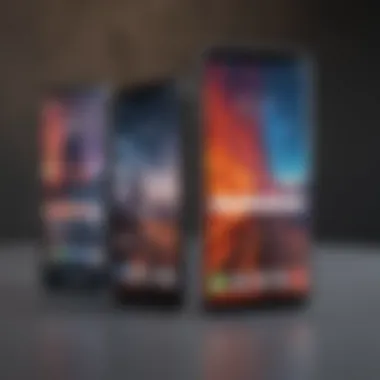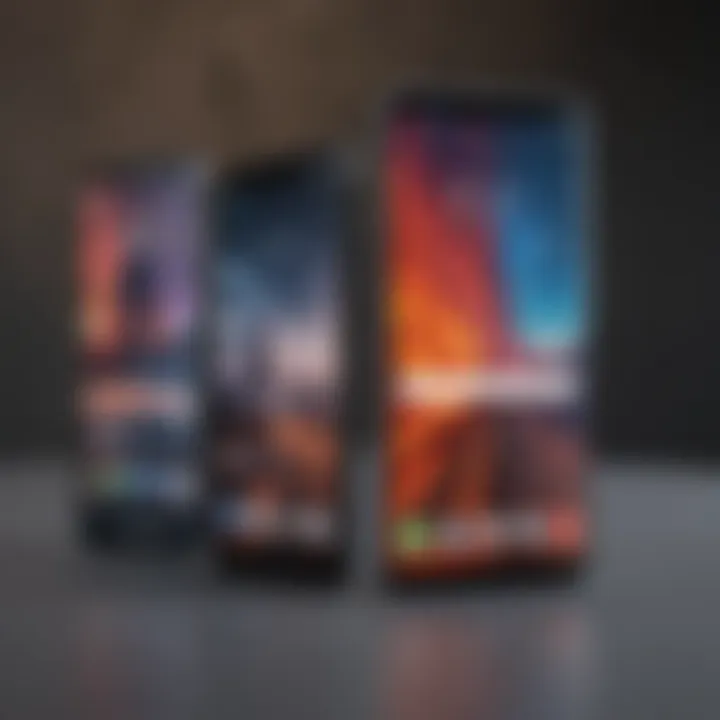Understanding Big Display Phones: Features and Benefits


Intro
The emergence of big display phones marks a significant shift in the smartphone landscape. These devices, often referred to as phablets, blend the functionality of smartphones with the expansive screen size reminiscent of tablets. As more consumers value visual experiences, particularly for media consumption and multitasking, the allure of larger displays continues to grow. This article seeks to dissect the nuances of big display phones, focusing on their defining features, associated benefits, and essential considerations for users.
Overview of Big Display Phones
Definition
Big display phones typically boast screen sizes exceeding six inches. This definition can vary somewhat depending on market trends, but the consensus remains that these devices offer expansive visual real estate for users. Brands like Samsung and Apple have led the charge in designing these larger phones, which cater to both casual users and tech enthusiasts.
Key Features
Big display phones come packed with several distinct features:
- High Resolution Displays: Many big display phones come with Full HD or higher resolution, ensuring crisp and clear visuals for videos and images.
- Enhanced Battery Life: These phones often incorporate larger batteries to support the demands of increased screen usage.
- Multi-Tasking Capabilities: Users can benefit from split-screen functionality, allowing multiple applications to run simultaneously without hinderance in performance.
- Improved Usability for Reading and Gaming: A larger screen allows for more comfortable reading of documents and web pages, as well as an immersive gaming experience.
Purpose and Benefits
The purpose of these phones goes beyond mere size. Here are some notable benefits:
- Increased Productivity: Big display phones facilitate multitasking, helping users manage work and personal tasks efficiently.
- Entertainment on the Go: A larger screen enhances video streaming, gaming, and social media interaction, making these devices popular among younger demographics.
- Visual Experience: The rich visuals provided by bigger screens improve the overall experience when consuming digital content.
The use of big display phones is not limited to just media consumption. Their utility in professional environments is changing the way people work and communicate on the go.
Types and Categories
Understanding the types and categories of big display phones can aid users in making informed decisions.
Popular Models and Brands
Some of the notable brands producing big display phones include:
- Samsung Galaxy S Ultra Series
- Apple iPhone Pro Max Series
- OnePlus 9 Pro
These devices vary in features like camera quality, performance, and user interface.
Pros and Cons
Pros
- Enhanced user interface experience for applications.
- Better ergonomic design for media consumption.
- Superior display quality that appeals to content creators.
Cons
- Reduced portability due to larger size.
- Potential for higher battery consumption during extended use.
- Greater cost compared to standard-sized phones.
Situational Uses
These devices are particularly useful in several scenarios:
- Travel: For navigation and entertainment during long trips.
- Work: Easy access to documents on larger screens for professional tasks.
- Leisure: Ideal for watching movies or playing graphics-intensive games.
Application Process
When looking to buy a big display phone, there are steps and considerations involved.
Steps to Apply
- Research different models and brands.
- Compare features and prices at various retailers.
- Read user reviews and expert opinions for further insights.
- Decide on a purchase method, be it online or in-store.
Eligibility Requirements
Most retailers require basic checks, such as:


- Valid identification.
- Payment method verification.
Documentation Needed
Ensure to have:
- Government-issued ID.
- Proof of payment method, if necessary.
Common Mistakes to Avoid
- Not researching enough before buying.
- Overlooking warranty and return options.
- Ignoring compatibility with existing devices or accessories.
Tips for Success
Prioritize understanding your needs. Consider how the larger display can enhance your daily tasks or leisure activities.
Costs and Fees
Types of Fees Associated
Given the premium nature of big display phones, users might face various fees:
- Initial Purchase Cost: Often higher than standard phones due to advanced features.
- Insurance Fees: If opting for device insurance, additional costs apply.
Comparisons of Costs Across Options
Prices can vary significantly. It’s wise to compare:
- Brand reputation and resale values.
- Feature sets that justify pricing.
Prelims to Big Display Phones
Big display phones have become a notable trend in the mobile technology world, capturing the interest of a wide range of users, from tech enthusiasts to everyday consumers. As smartphones evolve, the importance of large displays cannot be overlooked. This section aims to provide a foundational understanding of what defines big display phones, their significant evolution, and the implications of their growing presence in the market.
Defining Big Display Phones
Big display phones are typically characterized by their screen sizes, which usually exceed six inches diagonally. This larger dimension sets them apart from standard smartphones. The display provides users with a more expansive visual experience, enhancing the way content is viewed and interacted with.
Users often seek high-resolution screens, such as Full HD or higher, which allow for a clearer, more vibrant experience, especially when consuming media like videos and photos. Big display phones often come packed with features that make them suitable for various tasks, including multimedia consumption and productivity applications. They offer real estate that enables multitasking and a more immersive experience in gaming and video watching.
Though many consumers appreciate these attributes, it is important to understand the attributes that constitute a big display phone. Ergonomics also play a crucial role, as manufacturers attempt to balance screen size with user comfort. Knowing what qualifies a phone as a big display device helps in making informed choices for potential buyers.
Evolution of Mobile Displays
The evolution of mobile displays is marked by significant advancements that reflect technological innovations and changing consumer preferences. In the early days of mobile phones, displays were small, simplistic, and mostly monochrome. As the demand for richer media experiences grew, so did the screens' dimensions and capabilities.
LCD technology dominated the landscape for quite some time but has increasingly given way to OLED and AMOLED solutions. These newer technologies provide deeper blacks and brighter colors, enhancing visual experiences across diverse applications. With the introduction of higher refresh rates, users can experience smoother animations and transitions, making tasks like gaming and scrolling more fluid.
Today, we often see displays taking up nearly the entire front of the phones. Trends like edge-to-edge screens and foldable displays have shaped how manufacturers design their products. This continual evolution points to a remarkable shift in expectations regarding functionality and usability. Through this development, big display phones have settled in as a significant part of mobile technology's future.
Key Features of Big Display Phones
Big display phones have become increasingly prominent in recent years, particularly among young professionals and families. Their features play a crucial role in establishing their value and appeal. Understanding these key features allows consumers to determine how such devices can benefit their daily activities.
Screen Size and Resolution
A primary aspect of big display phones is the screen size. Generally, these phones boast screens above 6 inches. Such expansive displays provide an immersive experience for various activities, including video streaming or gaming.
Furthermore, resolution complements screen size. Higher resolutions, like Full HD, Quad HD, and 4K, enhance clarity. This leads to sharper images, making visuals more appealing. For example, a 4K display ensures sharp details during movie playback, thus improving overall entertainment value.
Display Technology
vs.


OLED
Display technology significantly influences the quality of visuals. The two predominant options are LCD and OLED.
LCD, or Liquid Crystal Display, uses a backlight to illuminate the screen. This results in bright displays, especially outdoors. However, colors may appear less vibrant compared to OLED.
OLED, or Organic Light Emitting Diode, differs by lighting each pixel individually. This allows for deeper blacks and more vivid colors. As a result, OLED offers a more dynamic visual experience, particularly in darker settings.
While LCD screens tend to be more affordable, OLED’s superior color accuracy makes it a popular choice for many flagship models.
Refresh Rate
The refresh rate is another determining factor for user experience. It refers to how many times per second a display refreshes its image, measured in hertz (Hz). Higher refresh rates lead to smoother visuals, which is especially beneficial for gaming and streaming content.
Common refresh rates include 60Hz, 90Hz, and up to 120Hz. A phone with a 120Hz display provides a significant advantage during fast-paced tasks, reducing motion blur. This characteristic enhances responsiveness and fluidity, making the overall experience more engaging.
Multitasking Capabilities
Big display phones excel in multitasking due to their ample screen space. Users can easily open multiple apps side by side, making it simple to switch between tasks without losing focus. For families, this can mean simultaneously watching a video while browsing the web. Young professionals can benefit when reviewing documents while participating in video calls. This capability significantly enhances overall productivity. With better multitasking features, users can get more done in less time.
Overall, the key features of big display phones offer numerous advantages. Understanding these attributes can help potential buyers make informed decisions that align with their lifestyle needs.
Benefits of Choosing a Big Display Phone
The growing popularity of big display phones has brought their benefits to the forefront. Many users weigh various factors before choosing a device, and the advantages of larger screens stand prominent. Increased screen size often leads to superior functionalities, enhancing experiences for entertainment and productivity. Considering these benefits is crucial before making a purchasing decision.
Enhanced Media Consumption
Video Streaming
Video streaming has changed the way we consume content, and big display phones elevate this experience further. Users enjoy clearer visuals and a more immersive approach. The larger screen size allows for better detail resolution, making movies and shows appear more vibrant. Moreover, platforms such as Netflix and YouTube have optimized their formats for bigger displays.
This characteristic makes watching videos more enjoyable, especially during travels or leisure time. Being able to see fine details can significantly contribute to the overall viewing pleasure. The unique feature here is the increased visual real estate which not only enhances enjoyment but also reduces the strain on the eyes. If users prefer to consume content on-the-go, this advantage cannot be overlooked.
Gaming Experience
Gaming is another aspect where big display phones shine. Mobile games benefit from larger screens that allow for better control and view of the gaming world. Players find it easier to interact with game elements without missing crucial action or details. For competitive or immersive games like PUBG Mobile or Call of Duty Mobile, the need for precision is paramount, making the big screen a valued asset.
The unique feature of a big display in gaming is its ability to enhance spatial awareness during gameplay. This leads users to increased enjoyment and often better performance. On the downside, some may find the larger device cumbersome during extended gaming sessions, but the benefits often outweigh this consideration.
Improved Productivity
Reading and Document Editing
Larger screens contribute significantly to document reading and editing. For professionals who rely on their devices for work, the added screen space allows for easier text navigation and editing. Be it for reading emails, reports, or documents, the extra width ensures that users can see more content at once without excessive scrolling.
This feature is especially favorable for those who often read PDFs or engage in document collaboration. Viewing multiple pages side by side can increase productivity drastically. However, some may find it challenging to carry larger devices to meetings or conferences.
App Usage and Multitasking
App usage and multitasking capabilities are crucial in today’s fast-paced environment. Users can run multiple applications simultaneously on a larger screen without overlapping interfaces. This utility enhances workflow efficiency, particularly for professionals dealing with various tasks daily. Responding to emails while referencing another document becomes seamless, promoting a fluid working experience.
The key characteristic here is the ability to split the screen or use picture-in-picture modes in various apps. However, users must also consider that multitasking does require more battery power, sometimes resulting in quicker drainage.
Accessibility Features
Big display phones often include accessibility features that make them user-friendly for a wider audience. Larger screens allow for bigger fonts and easier navigation, which is beneficial for those who may struggle with smaller displays. Many devices now incorporate voice control features to enhance usability. These functions significantly improve the overall smartphone experience for users of all backgrounds.
Considerations for Big Display Phones
When one decides to invest in a big display phone, several important considerations come into play. While these devices often boast impressive features and benefits, it is essential to understand the implications of owning such a phone. Portability, battery life, and cost are the primary facets that warrant careful analysis. Understanding these elements can guide users in making an informed decision on whether a big display phone is right for them.
Portability and Ergonomics


Big display phones typically feature screens that span over six inches diagonally. This larger screen real estate may enhance media consumption and provide a better experience for gaming or browsing. However, the size also affects portability. Carrying a device of this nature may require adjusting how one organizes their belongings. It can easily fit in a bag, but may not suit every pocket. Users should consider their daily routines and habits. Can they comfortably hold and operate the device with one hand? Some models are designed with ergonomics in mind, featuring curves and lighter materials to ease handling. Thus, while the display quality is often superior, the way a user interacts with the device can vary significantly based on its size and build.
Battery Life Implications
A significant aspect to consider with big display phones is their battery life. Generally, larger screens draw more power, which can impact battery longevity. The continuous usage of vivid displays for gaming, video streaming, and multitasking speeds up battery depletion. Users will need to factor in whether their lifestyle accommodates frequent charging. Many manufacturers are now focusing on enhancing battery capabilities to align with larger screens, but traders need clarity on actual performance. Checking user reviews and benchmarks can provide insight into how different models manage power consumption. As such, seeking a balance between screen size and battery effectiveness is crucial.
Cost Considerations
The price tag of big display phones can often be higher than their smaller counterparts. With advanced specifications, including larger and higher quality displays, enhanced camera systems, and more robust processors, the investment can escalate. Depending on the budget, users should evaluate how much they are willing to spend. It is advisable to consider models within the same price range but with varying screen sizes, as the price difference may reflect the screen's cost rather than overall performance. Users who carefully assess their personal requirements can ensure that they get value for their investment.
“Investing in a big display phone involves more than just its impressive features; you need to weigh portability, battery implications, and cost-effectiveness.”
Comparative Analysis
The comparative analysis section is crucial as it provides insights into how big display phones stack up against standard phones. This comparison helps users grasp the unique qualities that differentiate these devices, thereby aiding in their decision-making processes. By exploring key aspects such as usability, screen experience, and customer preferences, readers can gain a nuanced understanding of what these devices offer.
Big Display Phones vs.
Standard Phones
When evaluating big display phones against standard phones, several factors come into play. Firstly, screen size is the most evident distinction. Big display phones typically feature screens that range from 6.5 inches to 7 inches or larger. In contrast, standard phones usually fall within the 5 to 6.5-inch range. The size affects usable area, making tasks like typing and viewing more comfortable on larger displays.
In terms of media consumption, big display phones excel. Users benefit from enhanced video streaming and gaming experiences, with more screen real estate for graphics and text. The ability to split-screen with ease also adds to this advantage, making multitasking more effective.
Another significant element is usability. Users with large hands often find big display phones easier to operate. However, smaller devices may provide a more comfortable grip for individuals with smaller hands. The ergonomic balance is essential as it impacts how long one can comfortably hold the device.
Battery life can vary significantly based on the size of the display. Generally, larger displays consume more power, which can lead to shorter battery longevity if the device is not equipped with a robust battery. Therefore, while big display phones might offer outstanding features, they may come with compromises in battery performance, particularly when compared to standard models.
In summary, while big display phones offer numerous advantages, standard phones maintain relevance for users prioritizing portability and ease of use.
Market Trends and Preferences
The market for big display phones has shown a steady increase as consumers lean towards larger screens. A noticeable trend is the rising popularity among young professionals and families who often use their devices for various tasks. Whether video conferencing or mobile gaming, the need for a larger display is evident.
Recent market data indicate a surge in the adoption of big display phones in several demographics. This rise may be attributed to changing consumer preferences, where more individuals value entertainment functionalities. Additionally, with the proliferation of streaming services such as Netflix and gaming apps, larger displays have become almost essential.
Another factor is the development of technology that enhances the user experience. Advances in display technology, such as higher refresh rates and improved resolution, make big display phones increasingly attractive. Users are also drawn to models that offer better multitasking features, making it easier to juggle work and leisure on one device.
To align with market demands, manufacturers are introducing competitive pricing for big display phones. This strategy ensures that users feel they are getting value for their investment without sacrificing essential features.
Overall, the trends associated with big display phones reflect a growing preference for devices that cater to multimedia consumption and productivity, solidifying their place in the smartphone market.
Future of Big Display Phones
The conversation surrounding big display phones continues to evolve as new technologies and user preferences emerge. Understanding the future of these devices is crucial for consumers and manufacturers alike. As the market matures, certain trends and innovations dictate the direction of mobile technology. This section will explore significant technological advancements and changing user demands that shape the future of big display phones.
Technological Innovations
Technological improvements are central to the advancement of big display phones. Manufacturers are making strides in various fields such as display technology, battery efficiency, and overall design.
- Flexible Displays: Companies like Samsung have pioneered flexible OLED displays that allow for innovative designs, such as foldable phones. These models can provide a large screen experience while maintaining portability.
- Improved Battery Technology: The advent of new battery technologies aims to address the often-lamented issue of battery life in big phones. Solid-state batteries promise longer life and faster charging, addressing one of the more significant concerns for users.
- Enhanced Software Ecosystems: Operating systems are also adapting, with features that utilize larger screens better. Think of split-screen multitasking and advanced gaming options that leverage more extensive displays.
As these technologies continue to develop, big display phones are likely to offer more functionalities while becoming more user-friendly. The importance of ergonomics and usability will likely remain paramount in design considerations.
Changing User Demands
Consumer preferences are another significant aspect of the future of big display phones. User habits and needs are constantly shifting, driven by various factors.
- Work-from-Home Culture: With more individuals working remotely, the demand for productivity tools on phones has surged. Big display phones can fulfill this need, offering features like enhanced document handling and larger virtual meeting interfaces.
- Content Creation: As social media continues to rise, users increasingly seek phones that deliver high-quality video and photo capabilities. Larger screens fit this trend, allowing creators to edit and share content seamlessly.
- Personal Entertainment: Streaming services and gaming applications have transformed how people consume media. Big display phones cater to this demand by providing high-definition screens that enhance visual experiences.
Culmination
In this article, we explored the growing prominence of big display phones and their various aspects. This conclusion serves to encapsulate the essential themes covered, aiding in the understanding of why these devices are increasingly favored.
Summing Up the Key Points
Big display phones present a unique blend of features and advantages. Here are the key points to consider:
- Enhanced Media Experience: With larger screens, users can enjoy a more immersive experience while streaming videos or playing games. This aspect is crucial for those who prioritize entertainment in their mobile experience.
- Increased Productivity: The multitasking capabilities of big display phones enable users to manage various apps efficiently. The larger canvas supports reading documents or editing content, making it easier for professionals and students alike.
- Display Technologies: Different technologies like OLED and LCD offer distinct advantages. Users must consider their needs, such as color vibrancy or battery consumption.
- Portability and Ergonomics: While big display phones are beneficial, their size can impact portability. Users must weigh the convenience of a larger display against the practicality of carrying the device.
- Battery Life: Larger screens typically consume more power, which can affect usage. Understanding this balance is important for users who require long-lasting devices.
- Cost: Big display phones often come at a premium price point. Assessing value versus features is essential for budgeting decisions.
In summary, big display phones offer significant benefits that cater to diverse user needs. However, potential drawbacks such as portability issues and costs should also factor into the decision-making process. Ultimately, being informed allows young professionals, families, and students to choose the right phone that fits their lifestyle and requirements.



